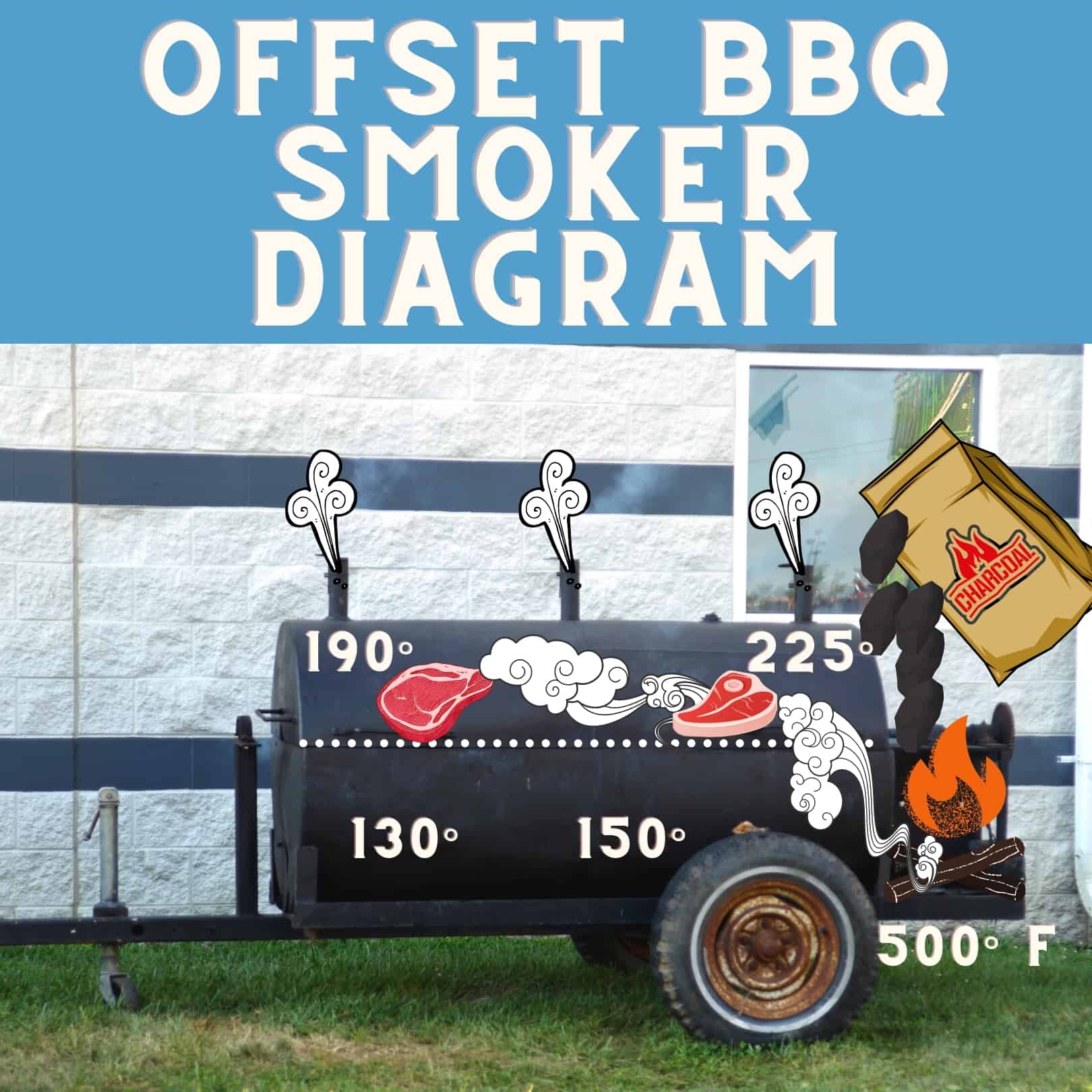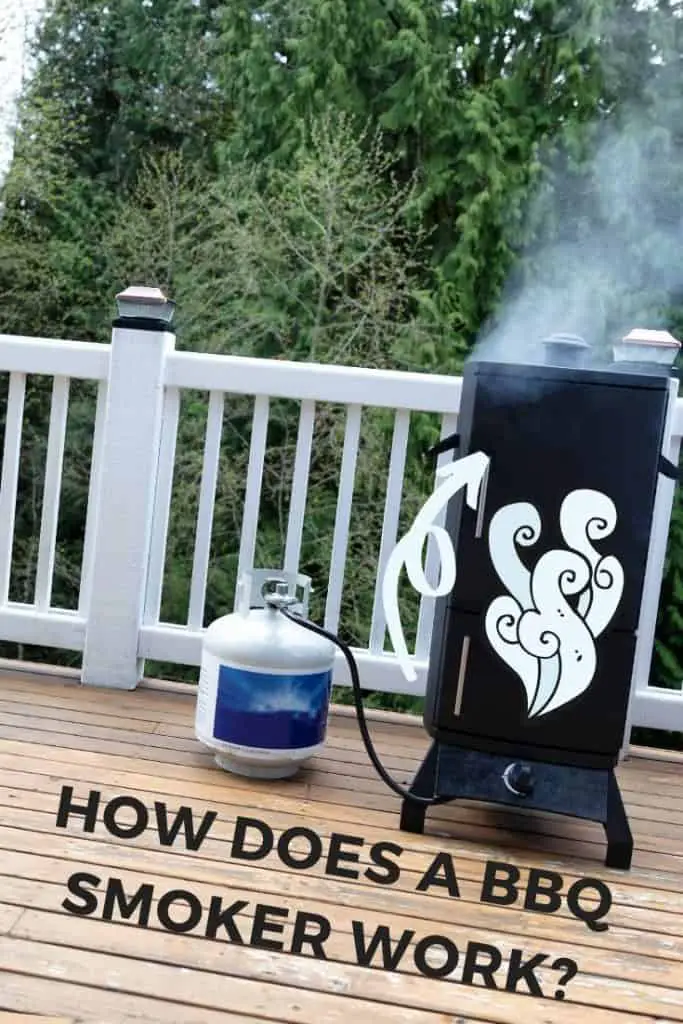It’s common knowledge that barbecue tastes great. But have you ever wondered how a BBQ smoker works?
Exploring the science of it could be as fun and exciting as slicing a roast rump served hot off the grill and inching that meat on a fork closer to your mouth.
Let’s find out by using a diagram and a video to explain!
In this post we'll cover:
How does a smoker work in a diagram

Above is an offset smoker diagram that shows exactly how a smoker works and how air flows through it:
- It’s the hottest in the offset smoker box, which is where your heat source is.
- Smoke flows through the smoker, and as heat always rises to the top, it’s hottest at the top of the smoker nearest to the box.
- Most vertical offset smokers only have 1 chimney, so the smoke and heat will travel along the top of the smoker to the far end.
- The coolest place in the offset smoker is at the bottom, and even cooler at the far end of the smoker.
The mechanics of smoking meat inside a BBQ smoker in a video
This YouTube video explains how a smoker grill works. But I’ll just elaborate a bit further for reference.
The popular term for smoking meat among pitmasters is known as “low and slow.”
This means that when you smoke meat, you set the temperature to low, and you smoke the meat for days or even weeks!
Essentially, what happens inside the smoker grill is that it all begins in the firebox where the wood or charcoal fuel is located and ignited, then allowed to burn continuously.
The heat and smoke then go into the smoking chamber (where you put the slabs of meat on the grates). It heats up the small water tray just below the grates, and the steam cooks the meat.
An air vent is provided for this type of smoker, and it allows you to control the temperature inside the smoker. This is the principle mechanism of most smokers.
It takes a long time to smoke meat. But the tradeoff is that the barbecue will taste great! It’s very soft to chew compared to other methods of grilling meat.
To elaborate it a little more, here is the working mechanism of some common types of smokers:

How does an electric smoker work?
An electric smoker works on the same principle described above, with many advancements that make the overall process much more convenient and controlled.
Electric smokers have a vertical design, with three main components that have a role in smoking meat:
- a heating element
- a water pan
- a wood chips pan
The wood chips pan is directly placed on the heating element, which is made of high resistance material. When electricity passes through the heating element, it generates heat.
This heat is then transferred to the wood chips pan, and this causes the chips to smolder. As a result, it generates smoke and heat, which turns the water into steam.
The smoke generated from wood chips gives the meat its particular flavor, while the steam keeps the meat moist as it cooks low and slow.
An electric smoker works more like an oven. It is very compact compared to conventional smokers. Moreover, it doesn’t transfer much flavor to the cooked meat.
However, where this might seem ridiculously inconvenient, it also has some perks.
With the steam and heat concentrated in a relatively smaller area, you are sure that the meat is getting consistent heat and moisture, resulting in a great final product.
In addition, you have all the control you need, which makes it super convenient for beginner pitmasters.
How does a pellet smoker work?
The mechanism of a conventional pellet smoker is a little different. It combines the characteristics of both offset and electric smokers.
Pellet smokers have three main components that play a significant role in heating:
- the hopper, in which we put the pellets
- the fire pot, which consists of hot roads that are used for lighting the pellets
- the auger, which feeds pellets to the fire pot
There’s also a fan in the cooking chamber that disperse the heat and smoke after the pellets start burning.
This helps circulate heat evenly throughout the chamber, ensuring the meat cooks evenly. Plus, it also keeps the flames from flaring up.
Modern pellet smokers also have digital dials and meat probes to tell you about the meat temperature as you smoke it low and slow.
That way, you won’t have to open the cooking chamber repeatedly to monitor temps.
You can also adjust the temperature by adjusting the airflow and increasing or decreasing the amount of pellets in the smoker.
Like electric smokers, pellet smokers also have easy functioning and are great for newbies in the world of smoking.
How does a vertical smoker work?
Vertical smokers encompass a category of smokers rather than a single type.
Those include:
- propane smokers
- most charcoal smokers
- electric smokers (which I have described already)
- kamado grills
- practically any type of smoker that stands up straight
Since the working mechanism of each smoker in the category is roughly the same, let me generalize it for you.
So, first things first, all vertical smokers consist of the same basic structure, having a heat source at the bottom, a wood chip tray above it, and a water bowl followed by it.
Above them are stainless steel grates where you put the meat.
The general principle of cooking is also the same for all; they flavor the meat with smoke, steam it with evaporated water, and cook it with the heat generated from both.
The primary heat source is the only thing differentiating vertical smokers from each other.
For example, vertical pellet smokers use pellets; gas smokers use propane, electric smokers use electricity, and so on.
Different types of meat and how they react to heat
There are 4 main types of meat that are edible on this planet, and those are:
- Red meat (beef, goat, and lamb)
- Poultry (chicken and turkey)
- Pork (pig)
- Seafood (fish, crab, and lobster)
Each of the meat types mentioned here reacts differently when it’s exposed to high temperatures like a gas burner, charcoal, or even wood fuel or pellets smokers like these.
For red meat, it’s the myoglobin that gives the delicious taste to beef or lamb steak.
Myoglobin is a protein that’s only found in muscle tissue. It also carries oxygen to the muscle tissues and has a red pigment, which is why human and animal muscle tissues are red.
Poultry meat, particularly chickens, also have myoglobin, albeit in lesser amounts than red meat.
In reality, chefs consider chicken meat as “boring” and as merely a blank canvas, a protein onto which you can paint a masterpiece of flavor.
Unlike beef which only needs salt and pepper, chicken meat requires a lot of marinades to enhance its flavor, which is why it seemingly tastes really good in any recipe, especially when barbecued.
Pork meat is called “the other white meat”, but it also has intermediate amounts of myoglobin. This is why it tastes a little different from red meat when smoked or grilled.
Now if you’re just as enthusiastic about smoking as me, then read up on how to build your very own smoker, or check out these top smoker brands.

